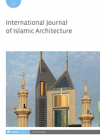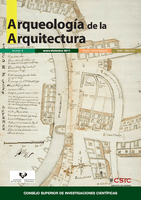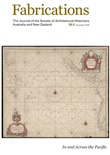
ArcHistoR-Architecture History Restoration
Scope & Guideline
Preserving Heritage, Inspiring Innovation
Introduction
Aims and Scopes
- Historical Architecture Analysis:
The journal emphasizes the study of historical architectural styles, techniques, and their evolution over time, providing insights into the cultural and social implications of architectural designs. - Restoration Practices and Theories:
It covers methodologies and theoretical frameworks related to the restoration of historical buildings, exploring how to balance preservation with contemporary needs. - Cultural Heritage and Urban Development:
Research often addresses the intersection of cultural heritage preservation and urban development, examining how historical architecture influences modern urban landscapes. - Interdisciplinary Approaches:
The journal promotes interdisciplinary research that incorporates perspectives from history, sociology, art, and technology, enriching the discourse on architectural heritage. - Case Studies and Regional Focus:
It frequently features case studies that highlight specific architectural sites, regions, or historical periods, contributing to a nuanced understanding of architectural practices in various contexts.
Trending and Emerging
- Sustainable Restoration Practices:
There is an increasing emphasis on sustainability in restoration practices, highlighting the importance of environmentally friendly approaches to preserving architectural heritage. - Adaptive Reuse of Historical Structures:
The trend towards adaptive reuse has gained significant traction, focusing on how historical buildings can be repurposed for modern uses while maintaining their cultural significance. - Impact of Socio-Political Contexts on Architecture:
Recent publications have started to explore the influence of socio-political contexts on architectural developments, particularly in regions with complex histories, indicating a broader interest in the relationship between architecture and society. - Digital Tools in Architectural Research:
The integration of digital tools for research and restoration practices is becoming increasingly prominent, showcasing the potential of technology to enhance the understanding and preservation of architectural heritage. - Public Space and Community Engagement:
Research examining the role of public space in urban environments and its relationship with historical architecture is on the rise, reflecting a growing interest in community engagement and participatory design in the preservation process.
Declining or Waning
- Modern Architectural Critiques:
Discussions around modern architectural critiques and their impact on restoration practices have decreased, suggesting a potential shift away from evaluating contemporary architecture's influence on historical preservation. - Traditional Preservation Techniques:
There has been a noticeable reduction in papers focusing exclusively on traditional preservation techniques, indicating a growing interest in innovative methods and technologies for restoration. - Architectural Education and Training:
Topics centered on architectural education, especially regarding restoration training, appear to have waned, as the focus shifts towards practical applications and case studies in real-world contexts.
Similar Journals

Journal of Historic Buildings and Places
Connecting Scholars to the Heart of Heritage.The Journal of Historic Buildings and Places, published by the esteemed Ancient Monuments Society, is a pivotal platform dedicated to advancing the study and preservation of historic architecture and cultural heritage. With an ISSN of 2753-2453, this journal serves as a sanctuary for researchers, professionals, and students who are passionate about exploring the significance of historic buildings, landscapes, and places. Its commitment to open access publication ensures that critical findings in the field are readily available to a global audience, thus facilitating wider dissemination of knowledge and fostering collaborative engagements among scholars. The journal contributes significantly to the ongoing discourse on conservation practices, architectural history, and heritage management, making it an essential resource for anyone committed to the study and preservation of our architectural legacy.

Disegnare Idee Immagini-Ideas Images
Catalyzing Collaboration in Design and Artistic ThoughtDisegnare Idee Immagini-Ideas Images is a distinguished academic journal published by GANGEMI EDITORE SPA, specializing in the fields of Architecture, Visual Arts, and Performing Arts. With an ISSN of 1123-9247, this journal serves as a vital platform for the dissemination of innovative ideas and research findings in these dynamic disciplines. Over its publication span from 2009 to 2023, it has established itself in the academic community, achieving a respectable ranking in the third quartile for Architecture and second quartile for Visual Arts and Performing Arts as of 2023. Although not an Open Access journal, it offers rich content that appeals to researchers, professionals, and students alike, fostering collaboration and dialogue among scholars in Italy and beyond. The journal is an invaluable resource for those looking to explore the intersections of design and artistic expression.

ARCHITECTURAL HISTORY
Illuminating the Intersection of History and DesignARCHITECTURAL HISTORY is a renowned journal published by Cambridge University Press, dedicated to advancing the field of architecture through scholarly research and critical analysis. Operating under ISSN 0066-622X and E-ISSN 2059-5670, this academic journal plays a pivotal role in disseminating knowledge related to the historical and theoretical dimensions of architecture. Though currently not open access, it offers invaluable insights for researchers and professionals interested in the evolution of architectural practices, spanning from the year 2002 to 2009 and continuing from 2011 to 2023. With a Q4 ranking in Architecture and a Q3 ranking in Visual Arts and Performing Arts as of 2023, ARCHITECTURAL HISTORY is well-positioned to contribute to the ongoing discourse in these fields. Furthermore, it holds commendable placements within the Scopus rankings, specifically 322/667 in Visual Arts and Performing Arts and 139/189 in Architecture, reflecting its growing influence. This journal serves not only as a platform for in-depth research but also as a critical space for scholarly exchange, making it an essential resource for students and academics alike who aspire to deepen their understanding of architectural heritage and its impact on contemporary practices.

International Journal of Islamic Architecture
Illuminating Contemporary Expressions of Islamic ArchitectureThe International Journal of Islamic Architecture, published by INTELLECT LTD in the United Kingdom, is a pivotal scholarly resource dedicated to the exploration of Islamic architecture, design, and cultural expressions within a contemporary framework. With ISSN 2045-5895 and E-ISSN 2045-5909, this journal targets an interdisciplinary audience by bridging the gap between architecture, geography, urban studies, and the arts. Established in 2012, it has swiftly garnered recognition, achieving notable rankings such as Q3 in Architecture and Q2 in Visual Arts and Performing Arts by 2023. Although it currently does not offer open access, its articles are meticulously peer-reviewed, ensuring high academic standards and relevance. Emphasizing the significance of Islamic architectural heritage in global contexts, the journal seeks to foster innovative perspectives and critical discourse, making it an essential platform for researchers, professionals, and students alike to engage with contemporary architectural practices and cultural dialogues.

Arqueologia de la Arquitectura
Illuminating the Past to Shape Tomorrow's ArchitectureArqueologia de la Arquitectura is a premier scholarly journal published by CONSEJO SUPERIOR INVESTIGACIONES CIENTIFICAS-CSIC, specializing in the intricate intersections of architecture, archaeology, and conservation. Since its inception in 2002, this Open Access journal has provided researchers, professionals, and students with a platform to share innovative findings that deepen our understanding of architectural heritage and its archaeological contexts. Based in Spain, it has demonstrated remarkable academic rigor and impact, achieving Q1 rankings in multiple categories, including Architecture and Visual Arts and Performing Arts, alongside a Q2 in Archaeology as of 2023. With a robust presence in Scopus, ranking within the 88th percentile for Visual Arts and Performing Arts, Arqueologia de la Arquitectura stands as a crucial resource for those dedicated to the preservation and study of our built heritage, encouraging interdisciplinary dialogue and research advancements in these elegant fields of study.

Techne-Journal of Technology for Architecture and Environment
Integrating Technology with Environmental ConsciousnessTechne - Journal of Technology for Architecture and Environment, published by FIRENZE UNIV PRESS, is an important academic platform that bridges the gap between technology and architecture while addressing the evolving environmental challenges of our time. Established in 2015, this journal provides a forum for innovative research and discussions that critically examine the intersections of architecture, urban studies, and construction engineering. With an impact factor indicative of growing recognition in its field, Techne encompasses a broad spectrum of studies, marking its presence in the Q3 and Q4 quartiles across various categories, including Architecture, Building and Construction, Education, and Health (Social Science). The journal is indexed in Scopus with varying ranks, showcasing its increasing relevance and influence among contemporary literature. Although it operates under a non-open access model, the journal ensures that its scholarly contributions are accessible through institutional connections, making it a vital resource for researchers, professionals, and students seeking to advance their knowledge on the integration of technology in shaping sustainable architectural practices.

Fabrications-The Journal of the Society of Architectural Historians Australia and New Zealand
Discovering Diverse Narratives of Architecture in Australia and New ZealandFabrications - The Journal of the Society of Architectural Historians Australia and New Zealand is a vital scholarly platform that explores the rich interplay between architecture and its historical context within the Australasian landscape. Published by Routledge Journals, Taylor & Francis Ltd, this journal serves as a crucial resource for researchers, professionals, and students in the fields of architectural history, urban studies, and visual arts. With an ISSN of 1033-1867 and an E-ISSN of 2164-4756, Fabrications has received recognition for its quality, placing in the Q4 category in Urban Studies and Q2 in Visual Arts and Performing Arts as of 2023. This journal not only welcomes innovative research articles but also encourages the exploration of New Zealand and Australian cultural heritage through diverse architectural narratives. With publications spanning significant years since its inception in 1989, Fabrications continues to provide an open forum for dialogue and discovery, catering to the academic and professional community's growing interest in architectural narratives through a regional lens.

Festival dell Architettura Magazine
Innovating Spaces: Where Architecture Meets CultureFestival dell Architettura Magazine, published by FESTIVAL ARCHITETTURA EDIZIONI, is a distinctive Open Access journal dedicated to the realms of architecture, urban studies, and the visual and performing arts. Established with a vision to foster interdisciplinary dialogue, the journal has been a part of the academic landscape since 2013 and has converged its insightful contributions from 2018 to 2023. Despite being ranked in the lower quartiles in its respective categories—Q4 in Architecture and Urban Studies, and Q3 in Visual Arts and Performing Arts—this publication remains vital for emerging researchers and seasoned professionals alike, as it provides a platform for innovative ideas and practices from Italy and beyond. It serves as a key resource for those who wish to engage with contemporary architectural thought and cultural expressions, facilitating open access to research that highlights the intersections of space, society, and art.

Studies in History and Theory of Architecture-Studii de Istoria si Teoria Arhitecturii
Fostering Global Dialogue in Architecture and ConservationStudies in History and Theory of Architecture - Studii de Istoria si Teoria Arhitecturii, published by EDITURA UNIV ION MINCU in Romania, serves as a crucial platform for scholarly dialogue in the interdisciplinary fields of architecture, conservation, and urban studies. With an ISSN of 2344-6544 and E-ISSN 2457-1687, this open-access journal has been disseminating valuable research outputs since 2014, facilitating global access to knowledge. Although it currently holds a Q4 quartile ranking in multiple categories, including Conservation and Urban Studies, the journal aims to elevate discussions surrounding architectural theory and history, safety, risk, and reliability in built environments. Positioned at the intersection of arts and humanities, the journal encourages contributions that challenge conventional paradigms and enrich academic discourse. As a vital resource for researchers, professionals, and students alike, Studii de Istoria si Teoria Arhitecturii is dedicated to nurturing the growth of architectural knowledge and its practical applications in contemporary society.

Loggia Arquitectura & Restauracion
Bridging Culture, History, and Design in ArchitectureLoggia Arquitectura & Restauracion is a pivotal academic journal dedicated to the fields of architecture, conservation, and the visual arts, published by UNIV POLITECNICA VALENCIA, EDITORIAL UPV in Spain. With an ISSN of 1136-758X and an E-ISSN of 2444-1619, this Open Access journal has been providing a platform for scholarly discussions since 1996, enhancing the global dialogue on architectural methods and restoration practices. Boasting a Q3 ranking in both Architecture and Conservation, along with a Q2 ranking in Visual Arts and Performing Arts, the journal reflects a commitment to academic rigor and innovation, as it navigates the convergence of these important fields from 2019 to 2024. The research published in Loggia addresses critical contemporary issues, enriching the knowledge base for academics, practitioners, and students alike. With a current Scopus rank that situates it within the competitive landscape of arts and humanities, Loggia serves as a vital resource for those seeking to explore the intersection of culture, history, and sustainability in architectural practice.